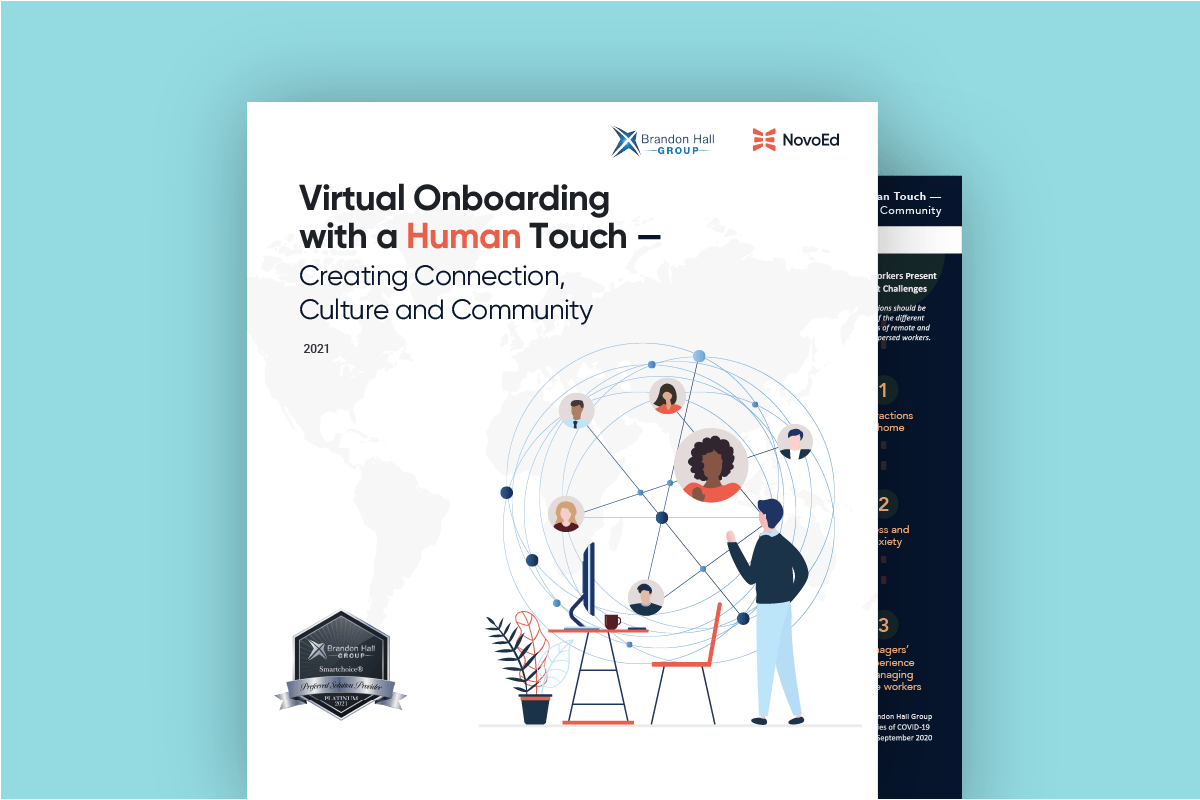Making Onboarding Remotely Engaging: A New Mission for the New Normal
Connection, culture, and community.
A successful onboarding experience isn’t just about learning policies and procedures — the deeper, implicit purpose is to create strong bonds between the new employee and the organization. But what happens now that a vastly greater number of people are working from home? How does a company maintain its culture and community when workers are located hundreds or thousands of miles from headquarters, and may never meet in person?
Before 2020, just 15 percent of employees worked from home. At the height of the pandemic, 75 percent of employees worked remotely. But we are not going to be able to turn back the clock: going forward, an estimated 38 percent of employees will be working remotely. (Brandon Hall Group New Realities of COVID-19 Study, July-September 2020)
Clearly, a greater level of remote work is here to stay. What does this mean for companies, and how should they onboard new employees?
HR to focus on best practices
Effective employee onboarding helps new team members feel like a critical part of your organization and increases their engagement and retention. When more workers were on-site, onboarding could happen more organically and through informal interactions.
Without the luxury of daily interaction, the online employee onboarding process needs to be more expansive, comprehensive, and intentionally planned. Here are a few tips that will make this process go more smoothly.
Help new hires understand the culture
Everyone knows they’ll have to fill out paperwork, learn new processes, and study the history of their new company. But how does a new employee learn about a company’s culture?
First, what exactly is culture? Lots of a company’s ideas, history and actions may be written down, but then again, maybe not. Culture is the sum total of an organization’s attitudes, ideals, and attributes. Is a company team-based and casual, or is it more formal and hierarchical? Does everyone clock in at the same time, or is there a looser attitude, allowing people to get work done in the hours that might be more flexible?
Culture is more than a mission statement or a list of organizational values. It is best absorbed through stories, such as formative moments in the organization’s history, when a senior leader talks about a tough decision or times when employee actions were rewarded or recognized.
In addition, culture is not a one-way street. New employees bring their own principles and perspectives, so there should be opportunities for them to offer their reflections, share past experiences, and discuss how they might handle different situations as they’re onboarded to the company.
Create connections and relationships
When people show up at the office for onboarding, they can’t help but connect, even if it is passing in the hallway, getting coffee, or bonding over an in-person icebreaker or group activity.
But what happens when people are working remotely? The ability to connect is even more critical, and employees need to build relationships with each other through other means.
Some ways that can help include forming small breakout groups; starting games that go beyond icebreaker activities; and placing new hires into teams to work on a joint deliverable. These actions bring critical social and collaborative elements to an online learning experience. I recommend planning for twice as many of these social exercises than you think you need for your onboarding program. They will provide numerous opportunities for the connections that are harder to create in the virtual world than in the physical world.
By using the onboarding process not just as a way to provide information, but as an opportunity to create connections, new hires can interact with their managers, mentors, and leadership through peer team experiences, learning in the context of work, and more. Done right, onboarding can allow a new hire to create an even more valuable network than employees who started in the office because their networking will not be limited to the people who just happen to sit nearby or work in the same building.
Cultivate a sense of community
Most onboarding programs bring in senior employees to explain or teach new employees based on their expertise. This is standard, but it can be expanded upon.
Subject-matter experts and managers bring company history and depth of knowledge, but aren’t involved in day-to-day business operations. That’s why it’s advisable to bring in employees from a variety of levels of the organization to round out the onboarding experience.
For example, a junior employee can lead breakout sessions. Or they can be paired with a new person as an “onboarding buddy.” It’s good to have someone approachable for new hires so they can get crucial information without having to bother a busy manager, or worry that they are adapting to the new environment quickly enough.
Also, technology can enable you to create moments of feedback, reflection, and proactive Q&A from the new team member to a designated onboarding buddy in an effective, efficient way as opposed to the default video conference that may take more time.
Empower new hires to contribute
Let’s face it: It is difficult being a new hire—learning new names, digesting a ton of new information, understanding the formal and informal organizational structure, and how processes and procedures work. It can be stressful.
New hires, though, don’t just bring their talents to your company. They also bring a wealth of experience, and their new perspective can spark creativity in their new place.
There is a magical “induction period” where new employees getting acclimated to your organization can apply their outside perspectives, question assumptions, or introduce ideas that can greatly benefit your company. During this critical time, you don’t want to overwhelm them with video conferences and fact-based materials that they are forced to master, stifling innovative thinking. To prevent this, incorporate onboarding activities where new hires can share ideas and feedback to make the process a two-way experience. Ask them to share best practices from their prior workplaces, or brainstorm ways to improve processes to better satisfy customers.
Let new hires see the onboarding process as a grace period in which they can ask any questions about the business and connect with anyone in the organization (within reason). This is their time to create an informal network of resources they may need down the line, and to think about the skills they may want to acquire or improve. They should also get the opportunity to form bonds in the cohort with new employees who are joining at the same time. They will progress through the organization together, many will become future leaders, and they will be able to tap into the peer relationships they forged during this formative period..
Let technology help
New hires will be digesting a lot of information, but what will they do with it? Instead of a quiz on the organization’s mission, maybe ask them to record a video of themselves explaining the mission as they might explain it to a friend. Or articulate one of the major challenges the organization is currently trying to address.
Also, managers, HR professionals and learning and development specialists can work with their IT and technology-focused colleagues to implement new tech-enabled learning methods and technologies that help employees apply their skills within the context of their employers’ strategy and practices in a remote work environment.
Taking onboarding seriously
With remote offices, there are fewer ways for people to experience an organization’s culture. In light of this, onboarding can in many ways be seen as the most critical part of the employee journey, as it sets the stage and tone for all future interactions. Now is the time to make sure that companies integrate their culture with the onboarding experience, and ensure that new employees are forming strong relationships, and getting what they need to be successful and prosper in their new environment.
Get ready to help your new hires and make onboarding a seamless, engaging experience. Download our e-book, Virtual Onboarding with a Human Touch: Creating Connection, Culture and Community.
Related Searches
Employee Onboarding, Virtual Employee Onboarding, Inclusive Onboarding



